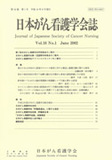Japanese
English
- 販売していません
- Abstract 文献概要
- 参考文献 Reference
- サイト内被引用 Cited by
要 旨
本研究は,Martha Rogersの「統一体としての人間の科学」に基づき,進行期がん患者が,化学療法の過程で患者と看護職者のエネルギーの場の相互的過程としての対話とマッサージの看護ケアを定期的に持つならば,患者の病気・治療体験は変化するであろうという考えのもとに行われた.質的,かつ縦断的で,解釈学的・弁証法的な研究デザインをとった.参加者は告知を受けて,手術が適応とならないために,残された治療法の中から化学療法を選択した進行期肺がん患者10名であった.
本看護ケアは患者に受け入れられ,彼らの病気・治療体験には以下のような3つの変化の特徴が現れた.1)患者の病気・治療体験は,混乱のなかでの出会いと関係の成立(局面Ⅰ),進化的創発の始まり(局面Ⅱ),統合による変容(局面Ⅲ),変容(局面Ⅳ)という少なくとも4つの局面を呈した.2)患者の病気・治療体験における転換点は,局面ⅡとⅢで生じ,感情の表出と認識の変化によって価値観や選択の方向が定まり,患者の立ち直りを促進した.3)転換点を経た患者にはその人固有の新しいリズムと元気がみられた.これらの現象はRogersのホメオダイナミクスの原理に基づいて理解することができた.
本看護ケアは,日常的に行われる対話とマッサージによる患者と看護職者のエネルギーの場の連続的な相互的過程であり,その過程でもたらされる患者の病気・治療体験の変化についての知識は看護職者にとって役立つものである.
Abstract
This study was based on Martha Rogers' science of unitary human beings. The qualitative and longitudinal approach was used as a hermeneutic and dialectic process to explore and describe the changes in experiences of adult participants in the nursing care with the integrated use of dialogue and massage. The whole process was taken as the interaction of energy fields between a participant and a researcher. Ten participants were adults with advanced lung cancer. They received chemotherapy a few days after the diagnosis. A partnership has been established between a client as participant and a nurse as researcher.
The search for evidence of changes in clients' in the face of difficult life situations was done with the ongoing partnership. The data analysis was focused on identifying patterns of the changes.
The four phases have been identified. Their experiences started with Phase Ⅰ, the establishment of the relationship after the encounter in the confusion. The clients started the interaction with the nurse as environment. Phase Ⅱ was the evolutionary emergence where the clients had expressed their real feelings better. Phase Ⅲ was the unification where the clients integrated their experiences to determine how to live in a new reality here and now. Phase Ⅳ was the transformation where the clients obtained future perspectives beyond their present relationship, attitude, perception, feelings, knowledge, values, choices, communication in the interaction between the client and the nurse.
The major turning point was observed during the Phases Ⅱ and Ⅲ. After expressing their feeling enough, the clients realized and understood the reality, and at the same time their new values and choices evolved. They regained energy and new rhythms in life.
The above phenomena have been observed in the framework of homeodynamic wave patterns defined in Rogers' nursing model. The integrated use of dialog and massage in oncology nursing care has created diverse changes in clients' experiences of the illness and the treatment processes. The knowledge on the patterns of the changes would be useful for oncology nurses.
Copyright © 2002, Japanese Society of Cancer Nursing All rights reserved.


